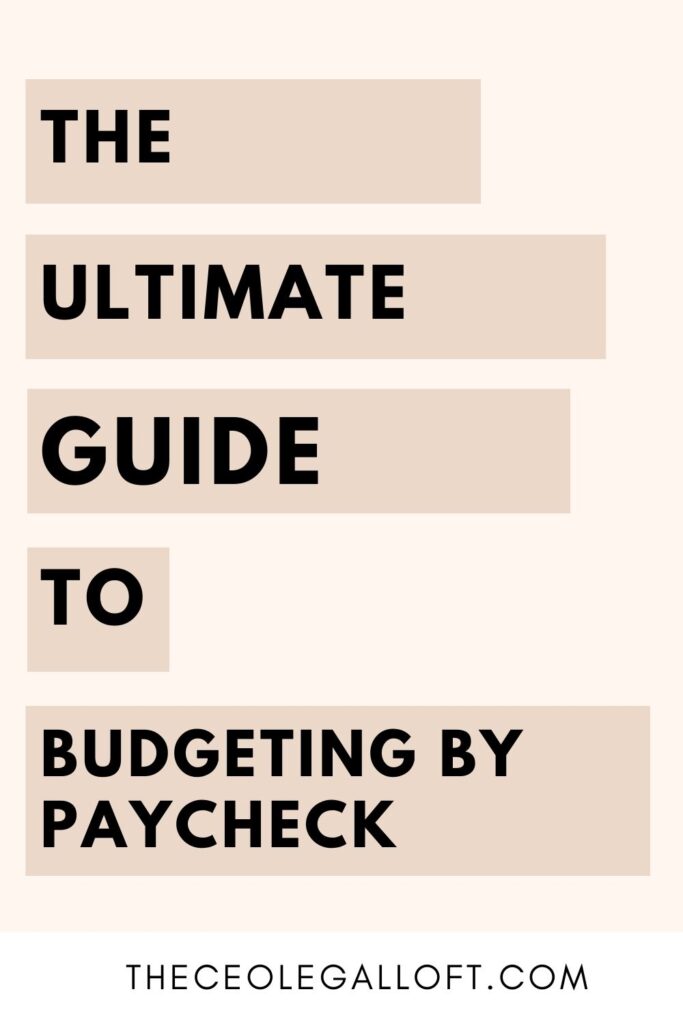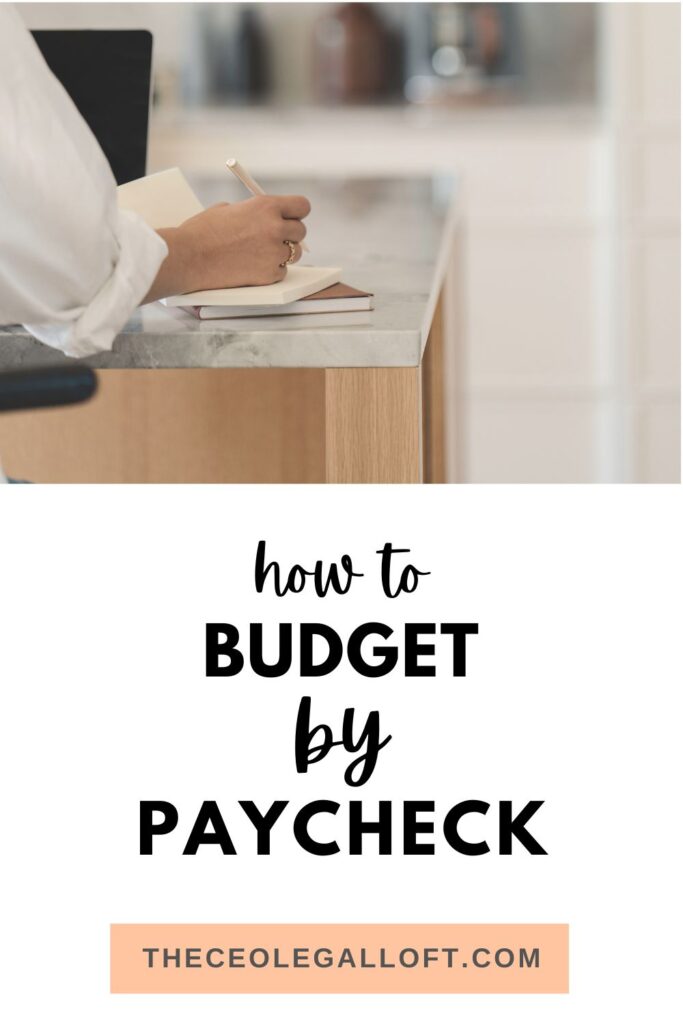Let’s face it, being an adult is tough sometimes, especially when it comes to managing money. Whether you’re drawing a salary from an employer or paying yourself from your own budding enterprise, the challenge of making every penny count remains. If you often find yourself juggling funds, eagerly awaiting the next paycheck, then this blog post is tailored just for you.
Today, we’re diving deep into the budgeting by paycheck method. A strategy that’s not just for salaried folks, but is equally transformative for business owners and freelancers who need to pay themselves. Managing business finances and personal expenses can be a juggling act, but this method offers clarity and structure to both worlds.
I hear you, “Budgeting? As if running a business wasn’t complex enough!” I get it, truly. As someone striving to swiftly clear a $13,000 credit card debt, I know the hurdles all too well.
But here’s the silver lining: Budgeting, especially when done right, can be your best ally. With some preparation, a sprinkle of discipline, and a grasp of essentials like emergency funds, financial aspirations, pay periods, monthly outlays, and the fascinating domain of cash envelopes, you’re setting yourself up for both business success and personal financial tranquility.
By the close of this read, whether you’re a 9-to-5 employee or a CEO in the making, you’ll be primed to take your finances by the reins. From crushing savings targets to affording those unplanned expenses, or just ensuring you enjoy the fruits of your hard work, you’ll make every paycheck—be it from an employer or your own enterprise—work in your favor.
Understanding the budget by paycheck budgeting method
At its core, paycheck budgeting is a tailored approach to managing your money. In my opinion, this the best way to start your budgeting journey to take control of your finances. Instead of viewing your finances on a distant monthly or yearly basis, this method zooms in on each paycheck you receive. The idea? To allocate every dollar purposefully every time you get paid, ensuring that your immediate needs, savings, and future goals are all addressed before the next payday. By honing in on individual paychecks, it becomes easier to see where your money goes and to adjust accordingly, avoiding the mid-month financial crunch.
Identifying Your Financial Goals
Identifying clear financial goals is paramount. These goals are split into two main categories: short-term and long-term. Short-term goals might include saving for a vacation, purchasing new tech, or paying off a specific debt. Long-term ones, on the other hand, might involve saving for a home, planning for retirement, or setting up a college fund. To chart out these goals, reflect on what you value most and where you want to be in the future. Once set, these goals play a pivotal role in paycheck budgeting. By keeping them at the forefront, every decision about allocating funds becomes more purpose-driven, ensuring that every dollar is a step closer to achieving what truly matters to you. You can allocate funds in a high yield savings bank account so that they’re gaining interest while saving. My high yield savings account with Ally, allows me to have “buckets” so that the funds appear to be separated for tracking purposes, however, all of the money is in one account. More and more banks have these “buckets”, also known as sinking funds, so check to see if yours does.
Determining Your Pay Period
The first step to budgeting to to determine your pay period. Your pay period is essentially how often you get paid. The most common types are weekly, bi-weekly, and monthly. Depending on your pay period, your budgeting approach will vary slightly. For instance, a weekly paycheck might require a more granular focus on immediate expenses, while a monthly paycheck calls for a broader overview, encompassing all of the month’s costs. The frequency of your pay period directly impacts your budgeting strategy: you’ll need to ensure that bills are paid, savings are accounted for, and spending is controlled until the next paycheck cycle arrives.
Your monthly budget is more than just a list of numbers. Think of it as a roadmap, guiding you to financial wellness, ensuring that every hard-earned dollar is used efficiently. Let’s dive deeper into each step:
- Calculate Your Net Income:
- Start by jotting down all your sources of income.
- Subtract mandatory deductions such as income taxes, Social Security contributions, insurance premiums, retirement contributions, and other similar deductions to get your take-home pay.
- If you have irregular income (like freelancing or commission-based jobs), take an average of the past few months to get a realistic figure.
- If you have a side hustle for extra money, include this in your monthly income.
- Remember, your net income is what you actually take home, and it’s the foundation of your budget.
- List Monthly Expenses:
- Go through your bank statements and see how much money you’ve been spending on your different expenses.
- Begin with fixed expenses: monthly payment that stay the same every month like rent, car payments, or car insurance.
- Move on to variable expenses: these might change from month to month, such as utilities, groceries, and transportation costs.
- Don’t forget about occasional expenses. While they might not come up every month, items like gifts, car repairs, or medical bills should be averaged out over the year and included as monthly expenses.
- Determine Your Debt:
- List down all your outstanding debts—this could be student loans, credit card balances, car loans, and so on.
- Include the amount owed, the monthly minimum payment, and the interest rate.
- While it’s essential to meet minimum payments, having a clear picture of your total debt will aid in creating a strategy to pay off debt faster.
- Set Spending and Saving Goals:
- Decide on a comfortable yet challenging portion of your income to save every month. Whether it’s for an emergency fund, a vacation, or future investments, having a target will keep you motivated.
- Allocate a specific amount for discretionary expenses like entertainment, eating out, and hobbies. It’s essential to enjoy life and have spending money while also being financially responsible.
- Adjust as Needed:
- Monitor your budget regularly. The first draft of any budget is rarely perfect.
- Use a budgeting app to track real-time spending or stick to traditional methods like keeping receipts and recording every expense in a budget planner or budget calendar.
- At the end of the month, review and adjust. Were there areas you overspent? Did you manage to save a bit more than anticipated? Adjust the next month’s budget accordingly.
- Remember, the goal isn’t to restrict but to empower. A flexible budget accounts for life’s ups and downs, allowing you to make informed decisions.
Lastly, remember that budgeting is a skill. Like any other skill, the more you practice, the better you become. Celebrate small victories, learn from mistakes, and watch as your financial health flourishes.

Understanding and Managing Monthly Expenses
Expenses can be broadly classified into:
- Fixed Expenses:
- Definition: These are monthly bills that remain the same amount every month. They are predictable, and because of that, they are the easiest to budget for.
- Examples: Aside from rent or mortgage, other fixed expenses include car payments, insurance premiums (health, car, life), loan repayments, and subscription services like streaming platforms or magazines.
- Budgeting Tip: Always allocate funds for these expenses first when planning your monthly budget. Since the amounts are constant, it’s crucial to ensure these obligations are met to avoid penalties or disruptions in services.
- Variable Expenses:
- Definition: Variable expenses can change from month to month. While you might expect these costs, the exact amount can be unpredictable.
- Examples: Beyond utilities and groceries, variable expenses can also include gasoline, phone bills (if you don’t have an unlimited plan), and household supplies.
- Budgeting Tip: Look at your spending in these categories over the past few months to estimate an average. It’s also a good idea to set a cap for these expenses to avoid overspending.
- Discretionary Expenses:
- Definition: These expenses refer to non-essential items or activities. They are the areas where you have the most flexibility in your budget.
- Examples: Besides eating out or entertainment, discretionary expenses can encompass shopping for clothes, gifts, hobbies, and leisure travel.
- Budgeting Tip: While these costs are non-essential, they contribute significantly to quality of life. Instead of eliminating them, aim for moderation. Allocate a set amount for these indulgences, and when it’s gone, wait until the next month or paycheck to indulge again.
Managing these expenses requires vigilance and organization. Using digital tools like budgeting apps can be extremely helpful in tracking your spending in real-time. If you’re more of a visual person, consider utilizing spreadsheets, such as The Smart Pay Scheduler, to track your bills with due dates and avoid late fees. This visual aid along with The Smart Money Split (personal) helps project future expenses, adjust allocations if necessary, and help you save. Periodic reviews, preferably once a month, can be eye-opening. By observing what’s going out of your account every month, it enables you to identify patterns in your spending. Maybe you realize you’re spending more on dining out than you thought or that your electricity bills spike during certain months. Armed with this knowledge, you can strategize on areas to cut back, ensuring that you’re not just spending, but spending smartly. This proactive approach will allow you to redirect funds toward vital goals like saving, investing, or accelerating debt repayments.
Setting Up Your Emergency Fund
An emergency fund is the financial safety net we all need, yet many of us often overlook. Picture it as a cushion against life’s unexpected bumps—car repairs, medical emergencies, or sudden job losses. Most financial experts recommend saving three to six months’ worth of living expenses as a solid buffer. But where to start? Begin by setting aside a small, manageable sum from each paycheck. Open a separate savings account (preferably high yield savings), if you can, to keep these funds out of easy reach and avoid the temptation to dip into them. Over time, with consistent effort, this fund will grow, providing peace of mind that you’re prepared for whatever life throws your way. I started out saving $1000 for my emergency fund, but the way life has gotten expensive, $2000 wouldn’t be a bad idea.
What about the 50/30/20 budget rule?
The 50/20/30 budget rule is a guideline for managing personal finances. It suggests dividing your after-tax income into three categories: 50% for essentials, 30% for lifestyle choices, 20% for financial goals. The essentials category includes expenses like rent/mortgage, utilities, transportation, and groceries. This category covers the necessary aspects of daily living. The financial goals category is for building savings, paying off debt, and investing. This portion of your budget helps secure your future and achieve financial stability. The lifestyle choices category includes non-essential expenses such as dining out, entertainment, and vacations. This category allows you to enjoy your money and have some discretionary spending. Following this budget rule helps ensure that you allocate your income in a balanced way, focusing on your basic needs, long-term financial aspirations, and maintaining a desirable lifestyle. However, it is important to note that the 50/30/20 rule is a general guideline and can be adjusted based on individual circumstances and priorities.
If you’re just starting your budget journey, I don’t suggest starting with this budgeting rule. Here’s what I’m following:
- Focusing on debt first.
- If you have no debt, focus on allocating your expenses, not overspending, and saving
- Once you’ve mastered allocation, not overspending, and saving, then you can be more intentional about the 50/30/20 rule.
For me, the biggest thing on my mind during this whole journey has been my debt and not going overboard with spending. I’ve been super focused on saving because I’ve been on a budget since 2014, so I’m not new to this whole financial journey. But over the past two years, I wasn’t as dedicated to following a budget and I’m paying for it now.

How to budget when you have an irregular income
For those with irregular income, budgeting by paycheck requires a bit more foresight. Start by determining your baseline monthly expenses and always prioritize covering those first. Then, during higher-earning months, set aside extra funds to cushion the leaner times, ensuring you always have a consistent amount to work with each pay period. This “buffer” approach can make an unpredictable income feel a lot more stable, allowing for more strategic budgeting.
Using Cash Envelopes for Effective Budgeting
The Cash Envelope System, an age-old practice, involves allocating a specific amount of cash in different envelopes for various categories (like groceries, entertainment, dining out). Having the money in your hand makes spending more mindful. By visualizing and physically handling the money, you become more aware of your spending habits, promoting frugality and intentionality. To get started, determine your categories, allocate your funds, and only spend what’s in each envelope until the next pay period.
On Fridays, I like to have a cash stuffing “ritual” over a nice cold glass of Prosecco and a lighted candle to bring an elevated experience to this otherwise mundane task.
Conclusion: Make a plan so you can stop living paycheck to paycheck
Navigating through the world of paycheck budgeting might seem overwhelming initially, but with practice, it’s a game-changer. You’ve now armed yourself with tools and strategies to maximize every dollar of your paycheck. I encourage you to take the leap, embrace this financial framework, and watch as your relationship with money transforms.
Ready to dive deeper? Consider grabbing our super simple spreadsheets for your personal finance journey and business budget.

+ show Comments
- Hide Comments
add a comment